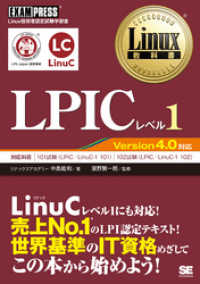- ホーム
- > 洋書
- > 英文書
- > Science / Mathematics
Full Description
The scanning tunnelling microscope (STM) was invented by Binnig and Rohrer and received a Nobel Prize of Physics in 1986. Together with the atomic force microscope (AFM), it provides non-destructive atomic and subatomic resolution on surfaces. Especially, in recent years, internal details of atomic and molecular wavefunctions are observed and mapped with negligible disturbance. Since the publication of its first edition, this book has been the standard reference book and a graduate-level textbook educating several generations of nano-scientists. In Aug. 1992, the co-inventor of STM, Nobelist Heinrich Rohrer recommended: "The Introduction to Scanning tunnelling Microscopy by C.J. Chen provides a good introduction to the field for newcomers and it also contains valuable material and hints for the experts". For the second edition, a 2017 book review published in the Journal of Applied Crystallography said "Introduction to Scanning tunnelling Microscopy is an excellent book that can serve as a standard introduction for everyone that starts working with scanning probe microscopes, and a useful reference book for those more advanced in the field". The third edition is a thoroughly updated and improved version of the recognized "Bible" of the field.
Additions to the third edition include: theory, method, results, and interpretations of the non-destructive observation and mapping of atomic and molecular wavefunctions; elementary theory and new verifications of equivalence of chemical bond interaction and tunnelling; scanning tunnelling spectroscopy of high Tc superconductors; imaging of self-assembled organic molecules on the solid-liquid interfaces. Some key derivations are rewritten using mathematics at an undergraduate level to make it pedagogically sound.
Contents
1: Overview
Part 1: Principles
2: Tunneling Phenomenon
3: Tunneling Matrix Elements
4: Atomic Forces
5: Atomic Forces and Tunneling
6: Nanometer-Scale Imaging
7: Atomic-Scale Imaging
8: Imaging Wavefunctions
9: Nanomechanical Eects
Part 2: Instrumentation
10: Piezoelectric Scanner
11: Vibration Isolation
12: Electronics and Control
13: Mechanical design
14: Tip Treatment
Part 3: Related Methods
15: Scanning Tunneling Spectroscopy
16: Atomic Force Microscopy
Appendix
Appendix A: Green's Functions
Appendix B: Real Spherical Harmonics
Appendix C: Spherical Modied Bessel Functions
Appendix D: Plane Groups and Invariant Functions
Appendix E: Elementary Elasticity Theory







